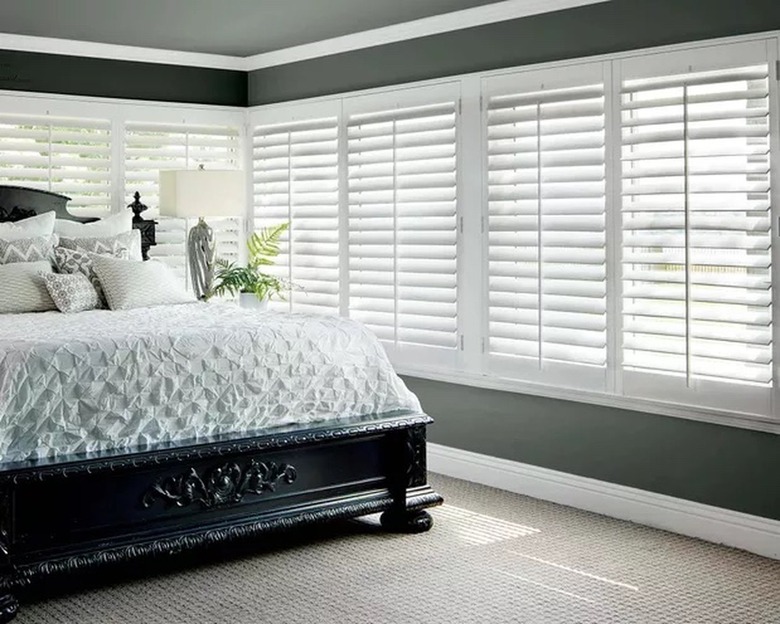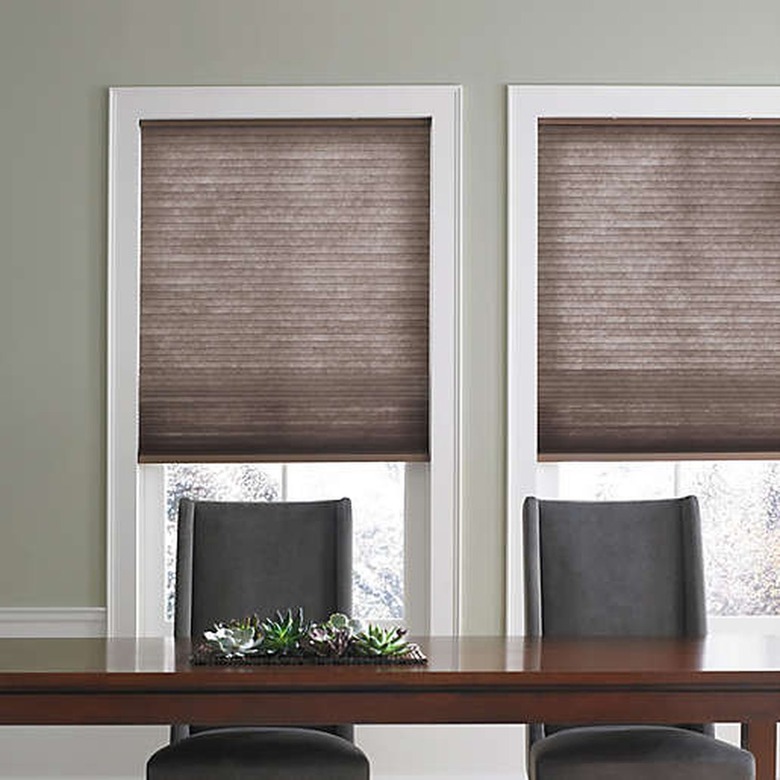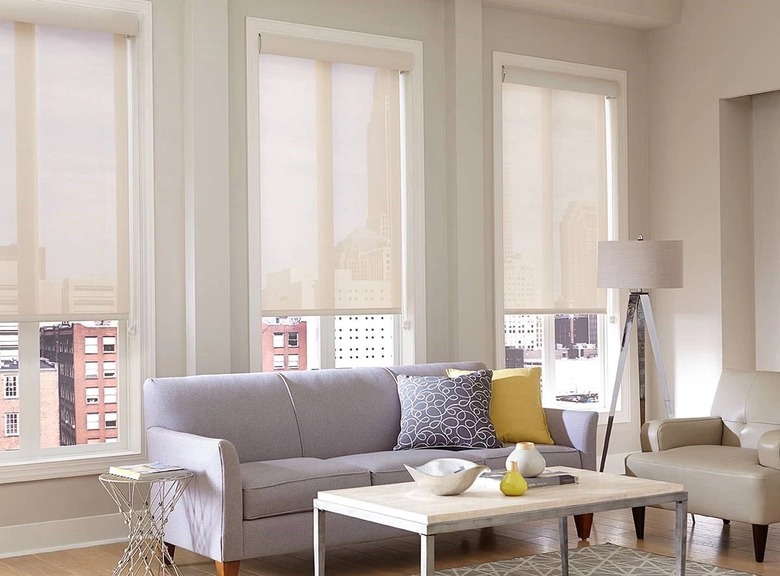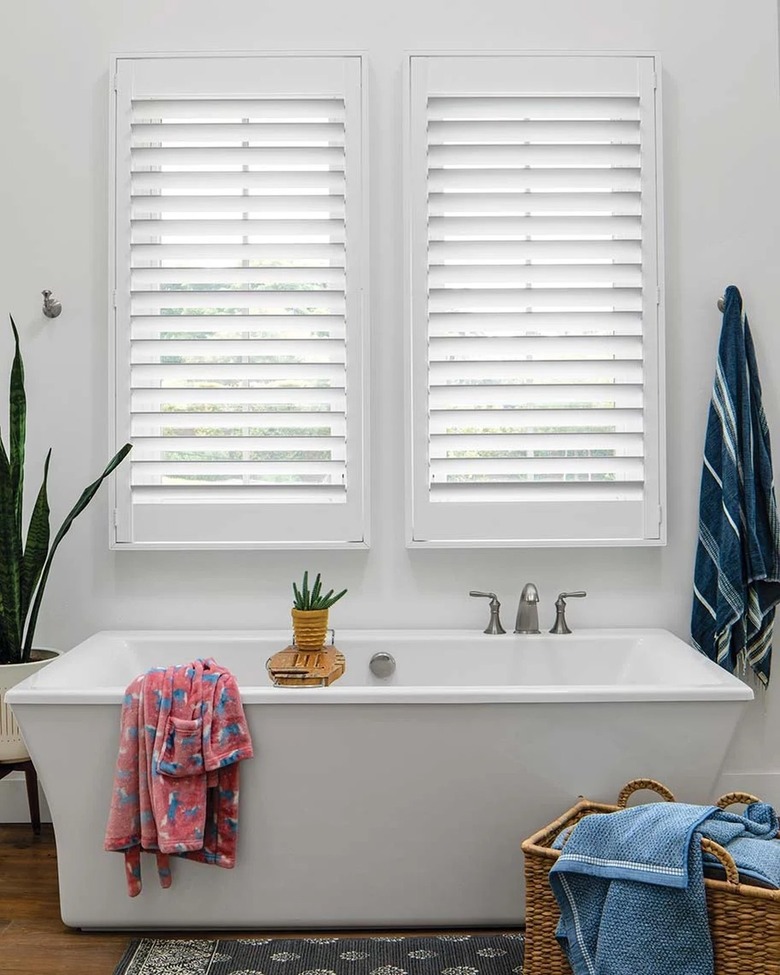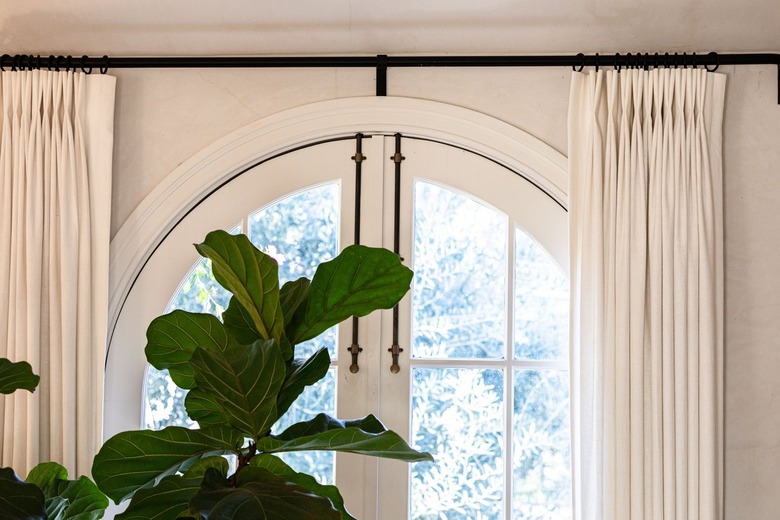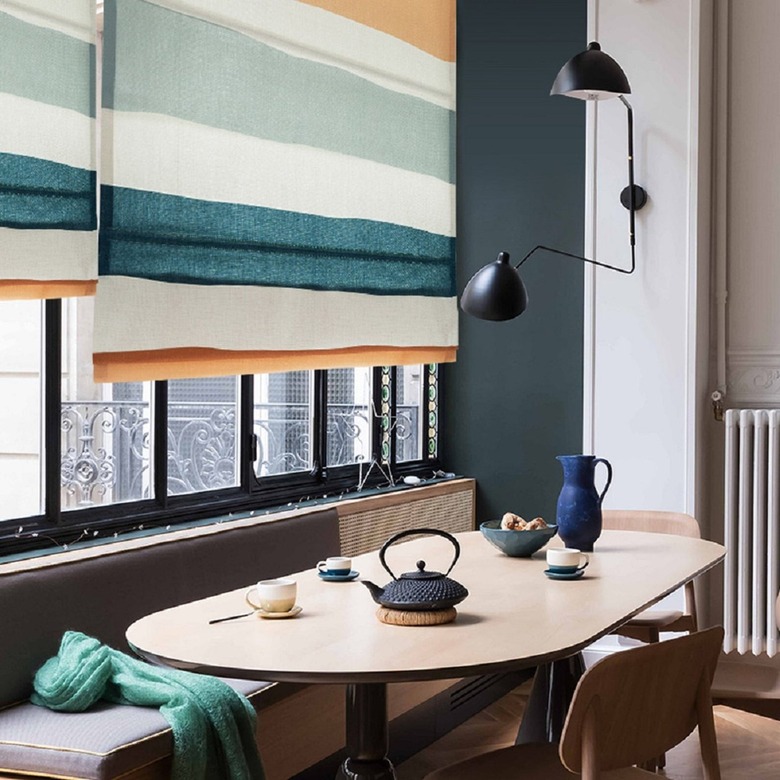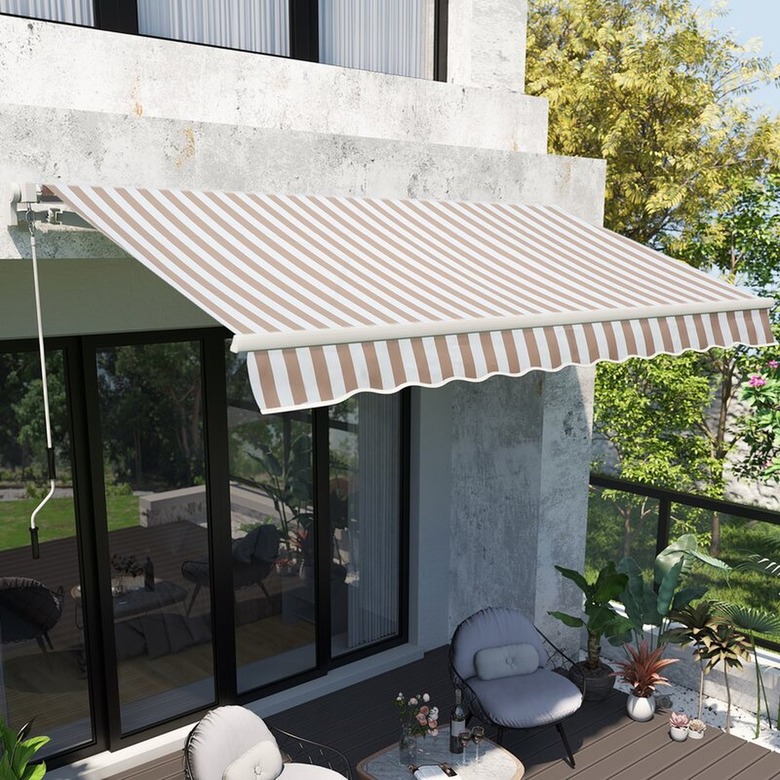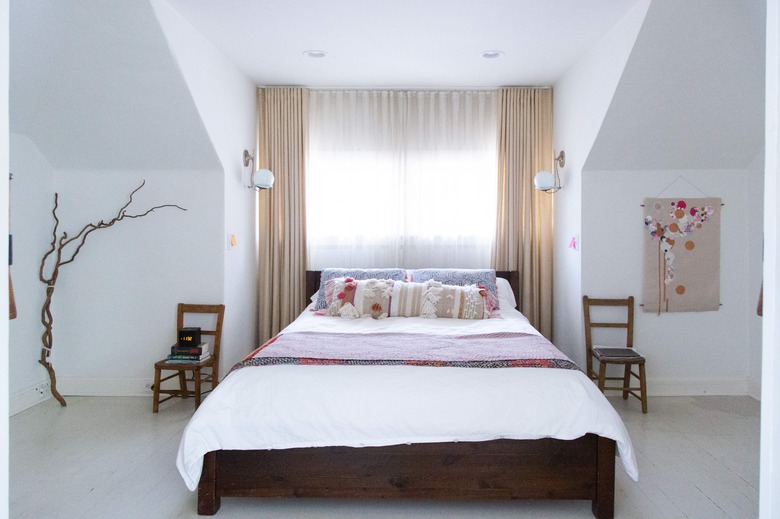The 8 Types Of Window Coverings That Help Beat The Heat In Your Home
If you can believe it, there are window treatments that actually have the capability to keep your home more comfortable and lower your energy bills. Though having natural light in your home is never something we want to complain about, it can heat things up and make it a bit stifling during the hottest months of the year.
When the sun's energy hits your windows, it heats the home's interior in two primary ways: conduction and radiation. Conduction occurs when the sun's heat warms the glass, and the glass warms the air around the window (which leads to another effect, called convection, that naturally circulates the heated air). On the other hand, radiation, or radiant heat, is caused by sunlight striking objects in the room; anything the light touches will warm up regardless of the outdoor temperature.
Solar energy warming your home is called "solar heat gain." This increases your energy costs in the summer by forcing you to run your air conditioning or fans more often. Reducing solar heat gain involves blocking light and/or insulating the room from the sun's heat. That doesn't mean you need to live in the dark or completely give up your views to the outdoors to stay cool, however. Flexibility with energy-saving window coverings lets you enjoy the view, the sunshine, and cool breezes when you'd like while blocking heat and harsh UV rays that fade fabrics, carpet, and other materials in your home.
1. Indoor Window Shutters
1. Indoor Window Shutters
Interior window shutters sit right inside the window frame to block the window completely when closed. They're made of solid materials, including wood, faux wood, and vinyl. Because they're made of thick materials, they can help trap hot air between the glass and the shutters to keep it from entering your room. The slats or louvers can close completely to block hot, direct sunlight during the summer heat, which also helps you feel cooler.
You can also adjust the shutters when desired by rotating the louvers up or down so they're partially open. This lets in some light without a lot of direct UV rays, but it won't trap the heat, so your room might feel a little warmer. Louvered interior shutters can also swing open if you want to let in full sunlight during part of the day.
2. Insulated Cellular Shades
2. Insulated Cellular Shades
Cellular shades, also called honeycomb shades, have lots of vertically stacked air pockets, called cells, that create an insulating effect. Installing cellular shades is a way to block harsh sunlight in the summer, but they also help add a little insulation in the winter on drafty windows that let in cold air. In cooler months, the pockets hold warmer air in your home, and in the summer, they hold cooler, air-conditioned air in your room while helping to block the heat from the sun.
The cell size affects the energy efficiency of these window shades, with larger cells providing more energy efficiency since they can trap more air. Double-cell versions offer greater protection against heat from the sun, but single-cell shades, which are generally cheaper, can also help, especially in moderate climates. You can also get triple-cell shades that work well if you live in an extreme climate and need the highest energy efficiency.
Cellular shades work in most areas and come in a range of opacity levels, including blackout, plus a variety of colors to fit your decor. Cordless versions are safer for kids and pets and offer an uncluttered look. They can absorb moisture and odors since they're made of fabric, so they're not ideal in overly humid areas or in kitchens, where they're exposed to both moisture and odors from cooking.
3. Solar Window Shades
3. Solar Window Shades
Roller shades are simple window coverings that roll up and down around a tube at the top of the window. One specific type is the solar shade, which is designed to block UV rays. They're made of a tightly woven mesh material designed to shield your interior from UV rays. Even with the solar shades closed, you still get some brightness in the room and can see the views outside your home.
These solar shades come with different openness levels, usually ranging from 0 to 14 percent. On the low end, up to about 5 percent, you get the most privacy and greatest protection from UV rays and heat, but you can't see much through the shades. Medium openness levels range from about 7 to 10 percent, giving you a little more of a view while still protecting against UV damage to finishes inside your home. The highest openness levels, up to 14 percent, give you the best views, but they're mostly used for glare reduction and not for blocking a lot of the heat and UV rays.
Light-colored solar shades are best for heat control because they help reflect the light away from your windows. Dark-colored shades are better for glare control, but they also help a little with heat control.
4. Louvered Window Blinds
4. Louvered Window Blinds
Louvered window blinds include all types of blinds that have slats you can adjust. While they don't control heat loss as much as other window treatments, they do give you control over direct sunlight entering the home and can reduce glare. Reflective blinds can help on hot, sunny days by reflecting the sun's rays and cutting down on heat transferring into your home through the windows. Since you can adjust the slats to different angles, you have more control over how much light enters the room.
5. Curtains and Drapes
5. Curtains and Drapes
Heavier curtains and drapes can help block the heat from sunlight to make your home more comfortable. Fabric selection affects how well your drapes or curtains control heat gain. Light-colored fabrics help reflect light, which can keep your home cooler, while darker colors hold heat inside your home, which can be helpful to keep your home warmer in the winter. If you want dark-colored curtains to match your room, choose drapery with a light-colored backing to help reflect the light.
Fabrics with a tight weave are also better at reducing heat transfer, which can keep your room cooler. Lightweight fabrics with a looser weave don't do much to beat the heat. Sheer and semisheer curtains are examples of window coverings that don't provide much cooling power. Room-darkening and blackout curtains offer the best heat control in your room because they're lined and have a tight weave.
6. Roman Shade Window Treatments
6. Roman Shade Window Treatments
Another option is to install Roman shades on your windows. These fabric window coverings stack up in even folds as you open them, and you can raise or lower the shades to the precise level you desire. When Roman shades are closed, the fabric blocks direct sunlight from entering the room, which keeps your home cooler in the summer. Roman shades made of heavy fabric can offer some insulation, which slows the heat transfer to the room.
7. Exterior Window Awnings
7. Exterior Window Awnings
Awnings over exterior windows block direct sunlight, which can keep your windows cooler and can help other energy-efficient window treatments indoors work more effectively. On south-facing windows, awnings can cut summer solar heat gain by as much as 65 percent. On west-facing windows, they can cut it up to 77 percent.
Older awnings were often made of metal, but modern window awnings are often made of low-maintenance synthetic fabrics that resist water, fading, and mildew. Opaque, tightly woven fabric in a light color is ideal to improve reflection of the sunlight away from the window.
Adjustable or retractable awnings can be better year-round than fixed awnings. In the winter, an awning can increase your heating needs since it blocks the sunlight that can help warm your house in the colder months. Removing, retracting, or adjusting awnings to a lower angle for the winter allows more sunlight to enter your windows in the winter for natural heating.
8. Layered Window Coverings
8. Layered Window Coverings
By layering multiple window treatments, you keep your home cooler while having more flexibility. You can pair multiple coverings that have varying levels of sun protection, which can double up on keeping your space cool. Layering also lets you adjust light levels and heat control throughout the day. For example, with sheers and heavy drapery, you can open the drapes early so the morning sunlight filters through the sheers. In the afternoon heat, you can close the drapes to block the UV rays.
